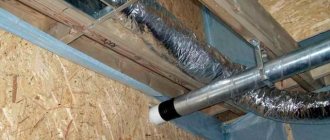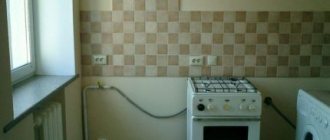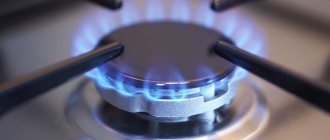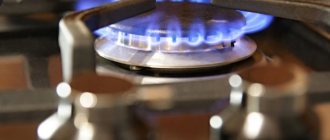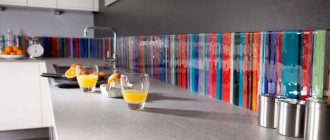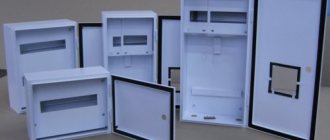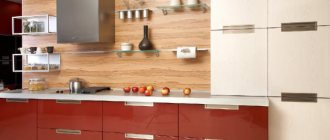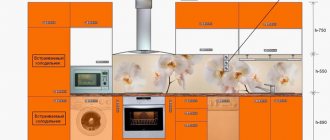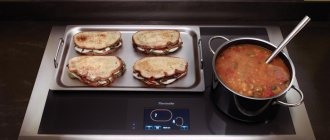When arranging their home or making cosmetic repairs in the kitchen, many people wonder what they can use to make an “apron” or “screen”. This is what we call the covering for the wall near which the gas stove is located.
First of all, it should be said how the concept of “apron” differs from the concept of “screen” - solely in size. The “apron” is the part of the wall located directly behind the gas stove; the “screen” is usually the entire wall next to which the stove is located, including the space between the wall-mounted and floor-mounted kitchen cabinets. But they have the same mission - protection from burning and grease. Therefore, we offer you the best ideas and practical tips on how to close the wall behind a gas stove.
Wall protection for gas stove
A protective screen, to put it simply, is the same as an apron, only larger. The main requirements for wall protection include:
- stable condition to high temperature and humidity;
- have a high degree of wear;
- the ability to simply clean the surface;
- beautiful and aesthetic design.
Such products are made from PVC film, on which a decorative pattern has already been applied. Such stickers are inexpensive, so if damage occurs, the surface can be refreshed. This is the most budget option for using the screen. If you want to make it durable, you need to choose durable and high-quality materials.
Insulation options
There are many non-combustible materials that can be used in this case. The easiest way to protect all surfaces from heat is to place a protective box around a red brick heat source. It is able to protect structures from heat and easily tolerates thermal effects. However, this decoration of the wall around the stove in the house looks a little unaesthetic and you can choose other materials:
- Porcelain tiles and tiles.
- Fiber cement boards.
- Factory-made protective screens.
- Metal sheets.
- Artificial or natural stone.
The easiest way to work is with a ready-made protective screen - you just need to select it according to size and install it on site. This option is also good because such finishing of walls near the stove or fireplace is done in the shortest possible time and without “dirty” or “wet” finishing work. The remaining options are more labor-intensive and have some nuances. Therefore, they need to be considered in more detail.
Screen materials
Below are the most common materials used to make slab screens. Laminated board made from MDF and chipboard materials is a budget option, but not so durable, the wear resistance of the protective film is quite low. Service life up to 5 years.
You can get out of this situation if you find a factory for the manufacture of entrance doors, where they will apply a special coating that is highly fire resistant and easy to clean even with abrasives and scrapers. It will not be as elegant, but durable. As a rule, it is just a screen of one color or a high-quality imitation of wood.
Artificial stone or porcelain stoneware
The product made from these materials is highly durable: resistant to large amounts of moisture, easy to clean, and can be used for many years. The downside is that the surface is not completely smooth, so dirt can get into the seams. Each type of composite material has its own individual properties.
- Artificial stone can be easily scratched by a metal object. However, this problem can be quickly corrected by sanding the surface with a power tool.
- Acrylic surfaces cannot withstand temperatures above + 80°C, so it must be attached as far as possible from the stove.
- It should be noted that porcelain stoneware and artificial stone will look aesthetically pleasing if the design and color of the countertop is harmoniously combined with the screen.
Metal
The metal is usually stainless steel. It perfectly protects walls from fire. However, otherwise there are more minuses than pluses. For example, such screens are thin, so they are easily deformed or pressed through. On such a surface traces of water or grease are visible. Another problem is that the metal sheets are attached to moisture-resistant plywood and secured to the wall. This substrate releases substances harmful to human health.
Tempered glass (triplex)
This is quite expensive, but a stylish and durable solution for the kitchen. If you make it as an apron, then you need to order it according to the individual dimensions of your kitchen. For the screen above the gas stove, standard versions from the store, made with fasteners, are also suitable. However, such a part will still be quite expensive in cost, but the most practical of all the materials presented above. As a rule, the standard thickness for such screens is 6-8 mm. Although these are small sizes, however, the thicker the glass, the more it begins to “green”.
If the screen does not match the planned style of the kitchen, then you can apply a beautiful design to the surface of the glass.
No. 7. MDF panels: a budget and practical option
You can make a kitchen apron from MDF panels: it will not cost much, but will be much more practical than finishing it with film or PVC boards. The main advantages of this method of finishing a working wall:
moisture resistance and strength;
quick production, because, as a rule, such an apron is created together with the kitchen set;
ease of installation. The walls do not require careful preliminary preparation, and the panels can be fixed either to the frame or using liquid nails
If you need to replace the apron, this can be done very simply - you don’t even need to remove the furniture;
seamless coating, which is important in a kitchen work area;
beautiful appearance: such panels can imitate ceramic tiles, stone, wood, brick, and recently a bright pattern has been applied to the material so that the apron becomes a real highlight of the kitchen.
But the material, unfortunately, has disadvantages:
- Not all detergents can be used to clean the surface. Too active substances can negatively affect the material, ruining its appearance and performance;
- flammability, so it is better to use MDF panels only in kitchens where an electric or induction stove is installed.
Materials for decorating an apron
Quite high demands are placed on materials for cladding kitchen walls. After all, housewives spend a lot of time in the kitchen preparing food. Therefore, it is very important that the environment is not only pleasing to the eye, but also practical.
Thus, materials for protecting walls from a gas stove must have the following characteristics:
- Moisture resistance . Everyone knows that humidity in the kitchen is always at a high level - steam during cooking, splashes of hot and cold water. All this can negatively affect finishing materials with low moisture resistance.
- Heat resistance . Near a gas stove, the walls always heat up, and quite strongly. Therefore, constant exposure to high temperatures can have a bad effect on wall coverings.
- Hygiene . In conditions of high humidity, bacteria multiply at incredible speed. Therefore, for the cooking area you need to choose a coating that will not absorb anything.
- Mechanical strength . This is one of the main requirements for finishing materials for the kitchen. The work area (apron) will be cleaned regularly. And it is very important to choose a material that will allow you to remove dirt without much effort.
- Aesthetics . In addition to all the above requirements, the material for kitchen walls should look organically in the interior, because the kitchen is a place where every housewife spends a lot of time. You should also immediately take care of masking the gas pipes.
Having dealt with the requirements that are put forward for materials for finishing the kitchen work area, we will talk about the materials themselves that are used for this purpose.
When thinking about what can be used to cover the wall behind a gas stove, most often people opt for ceramic tiles . This material is famous for its aesthetic qualities and affordable price.
The tiles do not absorb grease and other contaminants, so cleaning them is not difficult. In addition, the material has increased resistance to temperature changes and is not afraid of household chemicals. And the variety of shades and textures allows you to create the perfect design of your dreams.
The only drawback of ceramic tiles is the complexity of their installation, but we will talk about this a little below.
PVC film . It can also be used for cladding walls behind a gas stove. This is a fairly cheap type of polyvinyl chloride coating. The film can be textured or glossy, with or without a pattern. And you can buy it at almost any hardware store.
But, in essence, this is a one-time coverage option. After all, this material has extremely low wear resistance. It is more suitable as a temporary solution. For example, when you need to cover a more expensive finish.
We looked at the best ideas for wall decoration in this photo collection.
Mandatory conditions for transfer approval
As mentioned above, moving a gas stove requires approval, and in some cases the transfer is not possible at all.
Thus, it is forbidden to create a kitchen in any other living room. If you do not coordinate the redevelopment, then all this can threaten with fines and litigation, as a result of which, if the court decisions are not followed, you could lose the apartment altogether. Therefore, even if you are planning to move the gas supply to the household gas stove in the apartment, this step must be agreed upon.
We recommend that you familiarize yourself with the penalties for violating safety rules when using gas equipment.
A range hood is a necessary element in a kitchen where a lot of cooking is done. But when installing it, it is necessary to comply with a number of conditions: compliance with the established distances from the stove to the hood, compliance of the hood power with the kitchen area
However, there are a couple of redevelopment options that are usually approved and can be completed.
To transfer a gas stove to another non-residential room, several conditions must be met:
- the room where the gas stove will be located must be isolated from other living spaces;
- natural light is required;
- the gas pipe leading to the stove should not be routed through residential premises;
- connecting the ventilation duct from the main house exhaust ventilation.
Thus, fulfilling these requirements will guarantee that the redevelopment project will be approved.
It is worth noting that in apartments located on the first and second floors, where there are no other living quarters below, it is possible to move a gas stove to any other room, the main thing is that the conditions written above are met.
I stopped cleaning the kitchen every day. I’m sharing how to protect the stove and walls from splashes
Having moved to a new kitchen, the first thing I was concerned about was keeping it clean. In the first two days we managed to do a little work on the furniture and hob (steaks!). I had to take the time to wash the kitchen and the tiled wall. Then I went looking for ways and reviews on how to protect the stove from splashes.
The cleanliness of the stove when cooking has worried me for many years. I tried many devices, and none of them suited me 100%. Therefore, I chose to protect the stove from grease without much inspiration.
Looking ahead, I will say that this time I was able to select accessories that save surfaces from contamination. After frying, I didn’t need to wash the entire kitchen, which made me very happy.
I decided to write reviews about all the previously tested splash suppressors, protective plates and screens for stoves. And you decide for yourself what to choose. For some, my disadvantages may be insignificant, or they may be advantages.
Liquid soap
If you don’t have the time or desire to mix different components, you can simply apply a layer of liquid soap to the work surface. All the fat that gets on the stove during the cooking process simply will not have time to burn, so the surface can be easily washed off with a regular sponge. The role of the detergent will be performed by the previously applied liquid soap; you just need to rinse everything thoroughly with water.
Of all the listed methods, any housewife will find a suitable option for herself. These little tricks will help you forget forever about a thick layer of burnt fat and long cleanup after cooking dinner. At the same time, money will remain in the budget that was previously spent on purchasing many products for cleaning the stove.
Stove splash guards
As a result of searching and reading reviews on how best to protect the stove and walls from splashes when cooking, I discovered an interesting option. The idea is to isolate the splashing dishes as much as possible from the outside world. The idea is brilliant, that's what I found suitable for Ozone.
Food foil screen
Honestly, I was already planning to buy it, but I decided to read the reviews. Users write that the screen copes with its functions, but is quite soft. For less neat people like me, most likely, it will not work.
- Pros:
Budget-friendly, copes with its functions. - Cons:
Soft, which makes the screen difficult to maintain. Short-lived.
Steel splash guard
Very similar to the previous option, but more durable. The device is made of steel with a non-stick coating.
Eight-section screen for protection
For my taste, the functionality of the screen is much higher than that of previous options, because it practically hugs the dishes from all sides, protecting the epicenter of the splashes.
Theoretically, the cleaning area when using it will be minimal. But I was not able to check this, because according to Ozone, this screen serves as protection from the wind.
However, pictures on the Internet say that they can protect the wall and slabs from splashes.
Ammonia
Ammonia does an excellent job of removing dried, old stains. 1 tsp. diluted in 200 ml of water and applied to the stove. After ten minutes, wipe the area with a sponge or soft brush. You can also use ammonia-anise drops. For stubborn stains, leave them for half an hour or sprinkle soda on top and gently wipe with a damp cloth.
Use a toothbrush or a cotton swab dipped in ammonia to clean the handles and burners. Removable parts are soaked in an aqueous solution in a 1:1 ratio.
In addition, ammonia allows you to tidy up the smoked grate of a gas stove. To do this, the solution is applied to all areas. The grille is folded into a thick plastic bag and sealed tightly for 3-6 hours, depending on the condition of the part. Then all that remains is to rinse under the tap with a sponge and dish gel - the carbon deposits flake off, leaving a perfectly clean surface.
Splash suppressors
The simplest and cheapest way to help protect the stove from greasy splashes is splash traps in the form of a mesh lid. This device has never satisfied me with the level of protection. I think you too.
As soon as you lift the mesh above the frying pan, everything around is covered with greasy dots. Yes, a splash suppressor reduces the degree of contamination, but not the cleaning area.
There are two types of splash guards: like a regular lid, with a handle in the center, and like a small racket, with a handle on the side. I used both. I strongly do not recommend a sprinkler with a handle in the center. It becomes greasy during cooking.
Minuses:
copes 50%.
A simple device collects fat perfectly, it’s a pity that you have to lift it from the frying pan. And then, beware.
Communications
New and well-laid pipes and good plumbing are the key to the absence of breakthroughs. In any case, make it possible to easily and quickly access the communications under the sink and install additional valves there so that in case of emergency the water can be quickly shut off in this particular area.
If the apartment uses gas, entrust the replacement of the hose and connection of the stove to a professional. If you decide to replace it yourself, lubricate the joints with soapy water to make sure there are no bubbles and no leaks.
Electrical is also very important. It is ideal to connect the entire kitchen to a separate machine, that is, isolate it from the rest of the wiring in the apartment. Many appliances, such as electric stoves and ovens, dishwashers, some microwaves and even kettles require a power cable. Be sure to consult with an electrician to understand which devices can be combined into one network, and which ones will lead to overload and the plugs will constantly be knocked out. Place external sockets away from the sink and stove.
My life hack on how to protect the stove and walls from splashes
Not a single kitchen accessory does the job for my taste. Some splashes of fat from the frying pan quickly jump over the screen, staining everything around.
The splash suppressor in the form of a lid only works while in the frying pan. Although today I observed how small splashes of oil broke through the mesh.
Therefore, I decided to combine a protective screen and a splash guard. The area and intensity of pollution have noticeably decreased. Chose:
If you are interested in other protection options described in the article, they can be found here:
No. 2. Ceramic tiles: immortal classics
Most of us still choose ceramic tiles for our kitchen backsplashes, and for good reason. This is one of the best and most practical options , and it has a lot of advantages:
- high strength;
- heat resistance;
- ease of care;
- a huge assortment: you can choose tiles of any size, color and with any pattern;
- relatively simple installation, which with some skill you can even do yourself.
Using tiles, you can create a variety of effects, for example, highlighting a certain area using a material of a certain color: with decorative tiles, you can highlight the area near the stove or sink, and lay out the rest of the area with simpler tiles. It is worth noting that dirt can accumulate in embossed ceramic tiles and in the joints between the tiles, so it is better to choose the smoothest possible material and make the seams thin or varnish them. When combining tiles above the work area and other types of finishes in the rest of the kitchen, it is better not to settle on one color. It is better to separate the work area from the dining area in the kitchen by color , thus creating an effective zoning.
Primary requirements
Since the functions are the same, it means that the requirements for the surface of the kitchen screen will not differ from the characteristics of a reliable apron. Among them:
- Resistant to high temperatures and humidity;
- Wear resistance;
- Easy to clean;
- Attractive appearance.
However, some screens today are made in the form of a simple PVC film with a decorative pattern. You can buy such stickers for only 100-200 rubles, and it is assumed that as damage appears on the surface of the film, the owners will be able to immediately replace it with a new one. However, those who are used to doing everything well should choose a screen made of more serious material.
In conclusion
A kitchen apron is regularly exposed to negative influences: splashes of water, drops of fat and various products, high temperature, frequent washing. All this makes us look for the most practical and resistant material to all this. Everyone wants the kitchen to be attractive, stylish and harmonious, so another requirement is put forward for the finishing material - a pleasant appearance
In addition to ceramic tiles, there are many other ways to decorate a kitchen working wall: when choosing one option or another, it is important to compare all the pros and cons, consider how the material fits into the kitchen conditions, and only then make a decision
Tags:Kitchen
Laminated MDF or chipboard
A budget-friendly way to cover the kitchen wall behind the sink and hob, but also short-lived. The lifespan of such a plate barely reaches five years, and the protective film does not have sufficient wear resistance. But you can buy a 6 mm thick panel with a pattern already applied to it for only 1900 rubles/m2.
However, an alternative option is now available: look for a workshop for the production of entrance doors, where they can apply an anti-vandal decorative coating to a regular MDF sheet. It is fire resistant, easy to clean from difficult stains and certainly will not be scratched by a kitchen scraper. Don't expect any special artistic delights, but in some kitchens a plain screen or a skillful imitation of wood looks quite decent.
Laundry soap
For glass ceramics and enamels, a product based on ordinary brown laundry soap is excellent. Mix 2 tbsp. l. soda, 40 ml. vinegar and 1 tbsp. l. grated soap. You can add a little hot water to help the mixture dissolve better. The resulting slurry is left on the stove for 1-2 hours and washed off.
Stainless steel and enameled grates are immersed in a soap solution poured into a wide basin for ten hours, after which the soaked carbon deposits are well scrubbed off with a hard sponge. Removable verniers that are not too dirty can be soaked in a warm solution for twenty to thirty minutes, then wiped with the abrasive side of the sponge.
Triplex or tempered glass
The other extreme is a stylish and expensive glass screen, which in the kitchen can last longer than the furniture itself. You will have to order its production individually according to your dimensions if you want to assemble a large, full-fledged apron. But for a compact screen, only for the section of the wall above the stove, it may be possible to buy small standard panels with eyelets for fastening. But in general, the cost remains the same - 6-7 thousand per square. But in terms of practicality, this finish has no equal.
Keep in mind that for a protective screen, the optimal panel thickness is 6-8 mm.
This seems small, but with such dimensions the glass is already beginning to have a green tint. If this shade is not suitable for the chosen style of kitchen interior, you will have to buy lightened or, on the contrary, tinted panels. But more often, customers prefer glass screens with a beautiful pattern printed on the back.
Although glass screens are among the most expensive and may well exceed the cost of some types of artificial stone, from a practicality point of view they are the best solution for the kitchen.
And their price in comparison with durability will no longer seem to you a serious drawback and an unjustified waste of money.
Lemon acid
Use fresh lemon, lemon juice or citric acid powder dissolved in a small amount of water. The acidic composition is left for twenty minutes and removed with a damp cloth. A bonus from using this product is a pleasant lemon aroma in the kitchen.
Porcelain tiles, artificial stone
Durable and aesthetic, porcelain stoneware has all the necessary advantages: it is resistant to moisture and cleaning agents, and durable. The only thing in which this material is a little inferior to glass is that it is impossible to achieve that ideal smoothness on its surface, which simplifies maintenance. Even on polished porcelain stoneware slabs there are very thin seams where dirt will get in every now and then. And it is quite difficult to install due to its heavy weight. But everyone can afford to buy such a finish - the cost of a square of moisture-resistant tiles can be 400 or 4000 rubles.
You should differentiate which composite material you choose for your kitchen, as each may have certain properties. For example:
- Artificial stone is easily scratched by metal objects, but it can also be easily polished with hand-held power tools.
- The acrylic composite plate does not maintain temperatures above +80 °C and therefore should be located at a decent distance from the hob.
If you have chosen artificial stone or porcelain stoneware for an apron or protective screen, it is advisable that the finish completely matches the design of the countertop, otherwise you may not get a harmonious picture in the interior.
Kitchen set
When planning a kitchen set, you need to maintain the minimum permissible distances between electrical appliances and water sources.
If you are making a kitchen to order, the specialist will have to take them into account. If you are planning a purchase, for example, from IKEA and use their kitchen planner, there are text tips there. Read my personal experience of planning a kitchen at IKEA here. Basic principles: Do not place a stove and refrigerator in close proximity, or a stove and a sink. It is also recommended to make a spacer between the oven and the dishwasher.
Cabinets cannot be hung above the stove unless they contain a built-in hood. For the hood to work effectively, it must be placed at a distance of 70-75 cm (electric stove) and 75-80 cm (gas stove). It is not advisable for the corners of the hood to protrude in front of the wall cabinets; there is a risk of constantly hitting your head against them.
If you are attaching wall cabinets to modern, solid walls, use fasteners recommended by the manufacturer and no problems will arise. Old walls of Stalin and Khrushchev buildings may need additional fastening
Pay due attention to the fasteners, even if you are hanging open shelves - each of them has a maximum weight that they are ready to withstand. If overloaded or not fastened firmly enough, the shelves may collapse, and that would be good, if not on someone’s head.
The height of the wall cabinets depends on their depth and the height of the person who will cook. The optimal distance is 45-55 cm from the tabletop. A lower placement will cover part of the countertop. Deep cabinets especially need to be hung higher, but within sight, so as not to hit your head on them when bending over the work surface.
Before ordering a custom kitchen, to be on the safe side, draw out all future elements directly on the wall. When applying cardboard of the required width, see what the depth of the elements will be and whether it will be comfortable for you. Because in this case, it is comfort that ensures safety.
Metal
This is truly reliable protection for walls from fire, especially if you have a gas stove. However, in all other respects, the practicality of metal screens tends to zero. Firstly, they are too thin and without a perfectly flat base they are easily pressed and deformed. Secondly, if it is an absolutely smooth surface without relief, the slightest traces of water and drops of fat will be very clearly visible, just like on glass.
As a rule, the sheets are attached directly to panels made of moisture-resistant FB plywood and hung on the wall in this form. The problem is that the bakelite substrate itself is not an environmentally friendly material and releases harmful formaldehydes into the air.
Who is guilty
According to current standards, every slab manufacturer is required to ensure that its products successfully pass the thermal insulation test. In practice, this means the following: wooden surfaces located near the unit should not heat up above a critical level of 95 degrees . Within the permissible temperature range, heating is considered a completely normal phenomenon, does not complicate the use of the stove and does not lead to the release of harmful compounds from artificial wood (in particular, phenol-formaldehyde resins). “Advanced” devices with enhanced thermal protection allow the closest proximity to furniture.
If the headset is damaged, the manufacturer cannot be blamed unequivocally - much depends on the buyer himself. Before starting operation, the device must be distanced from the walls of the furniture by at least 2 centimeters on each side. If we are talking about gas stoves surrounded by wooden furniture, an additional safety net would not be superfluous - increasing the separation to 15 centimeters, as well as a slight extension forward (40-50 millimeters from the overall facade of the set). As a rule, manufacturers prescribe recommended parameters in the instructions, based on the technical aspects of a particular stove or oven.
In the future use of the stove, it is very important not to leave the burners on without a cookware - a single burner can raise the temperature of neighboring furniture to a whopping 200 degrees. Chipboard, varnished and plastic surfaces are especially vulnerable. Some materials become filled with cracks and become deformed, others become covered with stains and an “unhealthy” yellowness, others bubble and peel, and others risk melting or even catching fire. Often, heat does not spare silicone shock absorbers and PVC film.
When ordering built-in equipment, air gaps must be calculated doubly carefully. Progressive companies - such as AEG, Electrolux or, for example, Gorenje - provide high-quality insulation by default. Ovens are widely equipped with a blowing system, or tangential cooling: an internal fan draws in cold air from the external environment, drives it through the chamber along the hot walls and pushes it out through the slots above the door. Thus, excess heat is released, an air barrier is formed around the device, and the case maintains a neutral temperature. During operation, you need to be vigilant to ensure that the air holes are not covered or clogged with anything, otherwise it is unlikely that you will be able to avoid sad consequences.
Returning to the stoves, one more important aspect should be noted: they should not be in close proximity to the hood. According to experienced experts, it is advisable to maintain a distance of at least 70-80 centimeters - this norm applies to both gas and electric models.
Is it possible to cover the gas water heater with the facade of the kitchen. What did SNiP tell you about?
The fashion for cabinets with built-in household appliances has not bypassed gas equipment. Many representatives of furniture production offer their clients a sophisticated design of such cabinets for every taste. However, is it really possible to build a gas water heater into a closed kitchen cabinet? Building codes and regulations (SNiP) clearly state that this should not be done under any circumstances.
The column should be located on the wall at least 2 cm from it, both behind and to the side if gas equipment is installed in a corner. Moreover, nearby surfaces must have a non-flammable composition.
Main parts of the gas water heater: 1 – casing; 2 – traction diverter; 3 – heat exchanger; 4 – burner; 5 – gas unit; 6 – water unit; 7 – electronics unit (except for speakers with piezo ignition).
You can, of course, argue that this is not a problem and apply a safe coating to the inner surface of the cabinet. But, besides this, there are other requirements that prevent the placement of a gas water heater in a closet. If a gas leak suddenly occurs, a life-threatening concentration will very quickly form in a closed space. Only 5-15% in the room is enough, and since the gas does not have a pronounced odor, to enhance which the Odorant additive is used, it will be felt much later.
The installation of a gas water heater and all the details of its location are regulated by the section of SNiP relating to the gas supply area. Therefore, when starting a renovation, especially with replacing a water heater in the kitchen, it would be a good idea to study clauses 2.04.08-87, 42-101-2003, 42-01-2002.
Super brush for fighting grease in the kitchen AIHOME 3 in 1
Price: from 612.26 rub. (check price and discount)
Seller's reliability: excellent!
Delivery within Russia: free!
Customer reviews:
Review #1: The order arrived in 2 weeks, quickly, I think. The sponge itself is made of silicone, has bristles and a scraper as a tip. You can pour detergent into it, which is convenient. Cleaned trays and other utensils with ease. Thanks a lot!
Review #2: I didn’t think I’d say this, but this brush is a thing! Freaky as hell. Scrubs, washes and scrapes without damaging the surface. Silicone is moderately soft and flexible, which is very convenient for intensive use. I washed everything for her! Beauty!
Review #3: I decided to try something new and didn’t regret it. I washed dishes, barbecue grills and other utensils at the dacha after the barbecue season. Everything came together perfectly! Even the old fat has come off. Fairies can be poured into the tank, which speeds up the cleaning process. I have been looking for such an assistant for a long time and found it. I recommend it to everyone, honestly!
Cleaning well is great, but tasty and quick cooking is much better! Catch our selection of TOP 5 tricks for quick cooking from AliExpress and do it with pleasure!
TOP 5 goodies for fighting fat in the kitchen from AliExpress
Housewives, hey, we have found 5 effective means for quickly and accurately removing old dirt with 100% results, fortunately the Chinese industry is famous for this!
During the cooking process, especially when frying something in a frying pan until golden brown, small splashes of hot oil fly to the sides. They then harden on the surfaces of the countertop, kitchen apron, in general, wherever they got there and settled. And we are generally silent about dishes. everything is covered in old crusts and soot . Picture brrrr.
If you are familiar with this kind of trouble and you are not ready to give up and say: “I’ll buy a new pan and change the kitchen.” then scroll through our new selection, in which you can find 5 products tested by thousands of customers to combat fat in the kitchen.
Arm yourself with anti-fat products at generous prices from Aliexpress and win!
Set of melamine sponges for kitchen and household needs XC USHIO (20 pcs)
Price: from 86.49 rub. (check price and discount)
Seller's reliability: excellent!
Delivery within Russia: free!
Customer reviews:
Review #1: Good melamine sponges! They are disposable, so you have to wash everything at once! For the general manager - that’s it! Delivery to Germany 2 weeks. Thank you very much!
Review #2: I use this sponge all the time, dried-on grease comes off instantly. As soon as I pick it up I can’t stop)))) Thanks to the seller, the set will last a long time.
Review No. 3: Friends, well, the sponges were tested on the same day) the result is 5! Stains from concrete, the house was built 3 years ago, I haven’t tried anything to wash them during this time, the result was zero. There is probably a special tool for such purposes, but these sponges did the job without anything. Not without difficulty, of course))) They are also just right for the home - the oven and the soot on the pans came off perfectly!
Photo
Don't be afraid to experiment. The apron can be made from decorative stone panels, marble, natural pebbles, super washable wallpaper, brick and even wooden clapboard. The main thing here is to take into account certain areas, for example, near the slab you can apply glass as a separate element, on top of wallpaper or the same brick. Natural wood materials can be additionally treated with durable varnish, and a lot of other techniques can be used that will increase practicality and durability.
The interior of your kitchen can be very whimsical and individual, the main thing is not to be afraid and take action, and practical advice will help you implement your own ideas correctly and without mistakes. There is no friend according to taste and color, and if you suddenly decide to implement an interesting idea, then go towards your goal by combining and combining various building materials.
